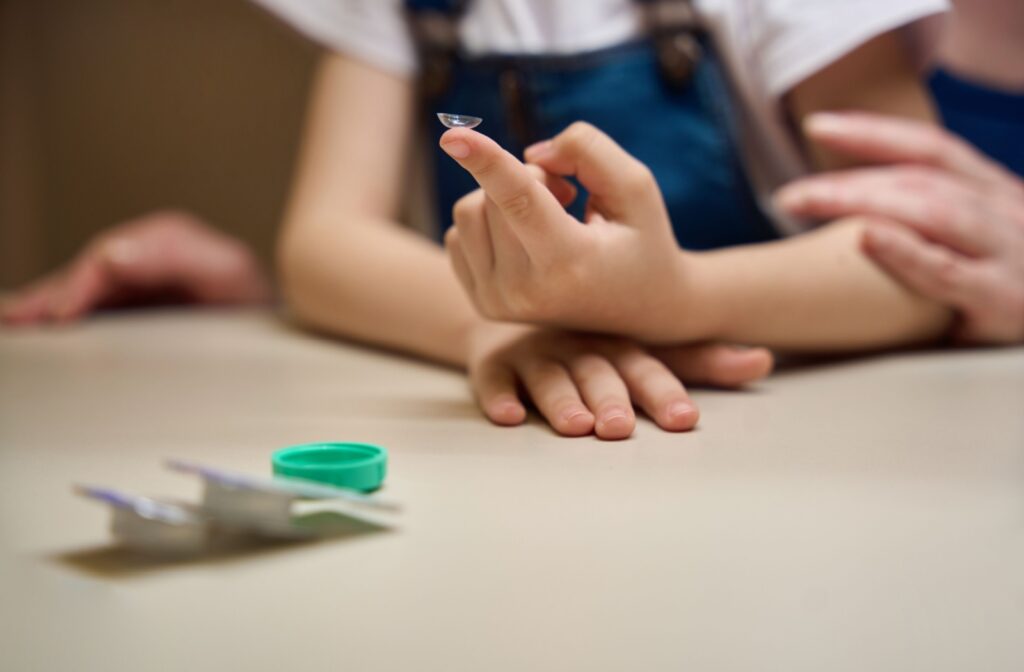For many kids, wearing glasses can be a hassle—especially during sports, outdoor play, or even just everyday life at school. Contact lenses offer an alternative that can give children more freedom and flexibility. While not every child is ready for contacts at the same age, many do benefit from switching to lenses with the right guidance and support.
Choosing the right lenses for your child involves more than just picking a prescription. It means finding a solution that fits comfortably, suits their lifestyle, and supports their eye health. This often includes options like daily disposables or myopia control lenses.
When Are Kids Ready for Contact Lenses?
There’s no single age when kids should start wearing contact lenses. Their readiness depends more on maturity and motivation than on a specific number. Some children are comfortable handling contact lenses as early as 8 or 9 years old, while others may benefit from waiting until they’re a little older.
Signs a child may be ready include:
- They consistently follow hygiene routines, like handwashing and tooth brushing
- They express interest in wearing contact lenses
- They are responsible with their belongings and follow directions well
Parental involvement is often key in the early stages of contact lens wear, especially for helping with insertion, removal, and cleaning routines. With time and practice, many kids can develop independence and confidence in managing their lenses.
Types of Contact Lenses for Children
Several types of lenses are suitable for children, depending on their vision needs and how involved they want to be in daily care. Each option offers unique benefits, especially when tailored to a child’s lifestyle and eye health.
Daily Disposable Lenses
Daily disposables are one of the most popular choices for children. These lenses are worn once and then discarded at the end of the day, which simplifies their care routine and lowers the risk of buildup and infection.
For busy kids and families, daily disposables are convenient, as there’s no need for cleaning solutions or storage cases. Daily disposables also reduce the chance of kids overwearing their lenses, since each pair is fresh and clean.
Monthly or Biweekly Replacement Lenses
Some children, especially older ones, do well with reusable lenses that are replaced every two weeks or once a month. These lenses must be removed, cleaned, and stored each night.
While reusable lenses can be more cost-effective over time, they do require a higher level of responsibility. Kids who are already familiar with contact lens hygiene or have help from a parent may find them manageable.
Myopia Control Lenses
Children with myopia, or nearsightedness, may benefit from specialized lenses designed to slow the progression of their condition. These contact lenses work by altering the way light focuses on the retina, which may help prevent the eye from lengthening too quickly.
Some soft contact lenses, such as MiSight lenses, are FDA-approved for myopia control in children. These lenses are typically daily disposables and are prescribed as part of a broader myopia management plan that may also include regular eye exams and lifestyle guidance.
Orthokeratology (Ortho-K)
Ortho-k lenses are rigid gas-permeable lenses worn overnight while a child sleeps. These lenses temporarily reshape the cornea, allowing for clear vision during the day without the need for glasses or contact lenses.
This option can be appealing for active kids or those who don’t want to wear anything on their eyes during school or sports. Ortho-K is also frequently used for myopia control.
What to Consider When Choosing Lenses for Your Child
Every child’s eyes and lifestyle are unique. The best contact lens option depends on a few important factors:
- Age and maturity level
- Level of parental support and supervision
- Type and severity of vision correction needed
- Lifestyle preferences, such as involvement in sports or screen time habits
- Risk factors for dry eye or sensitivity
A contact lens fitting with an experienced optometrist is a key step in identifying the right choice. Fittings typically include a comprehensive eye exam, corneal measurements, and a discussion about your child’s daily routine and vision needs.

Helping Kids Adapt to Contact Lenses
The first few weeks of contact lens wear can be a learning curve for kids. They’ll need time and guidance to feel confident about inserting and removing lenses. Starting with shorter wear times and gradually building up can help ease the transition.
Here are a couple of common tips for making the transition more comfortable:
- Practice in front of a mirror with supervision
- Encourage consistent handwashing habits
- Keep extra lenses and solution on hand
- Schedule follow-up appointments to monitor comfort and fit
Some children may adapt quickly, while others need more time to build confidence. Patience, positive reinforcement, and clear instructions can all help foster success with lens wear.
Why Contact Lenses Can Be a Good Option for Kids
Contact lenses can do more than improve vision. They often also contribute to improved self-esteem and participation in physical activities. For kids involved in sports, contact lenses offer clear peripheral vision.
In the case of myopia management, contact lenses can also support long-term eye health. Slowing myopia progression may reduce the risk of future eye conditions linked to high myopia, such as retinal detachment or glaucoma. If you’re curious whether contact lenses could be the right fit for your child, our team at Tree City Eyecare is here to help. Book an appointment today to explore comfortable, kid-friendly options that support both clear vision and long-term eye health.


